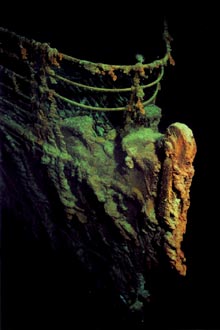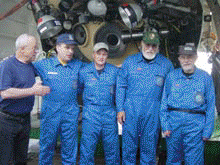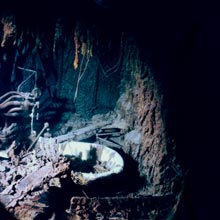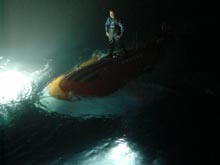A view of the bow of the Titanic from a camera mounted on the outside of the Mir I submersible. Click image for larger view and image credit.
Scientists from the United States and Canada were invited to participate in this historic expedition to conduct detailed observations for ongoing research. Scientists also conducted qualitative analyses of the microbial communities, called rusticles that help contribute to the scientific research regarding the ship’s degradation. See this visual log of the entire 2003 Titanic exploration.
![]() Click image to view a slide show.
Click image to view a slide show.
R.M.S. Titanic Expedition 2003
June 22 – July 2, 2003
Lieutenant Junior Grade
Jeremy B. Weirich
Marine Archaeologist
NOAA Office of Ocean Exploration
Laura Rear
Knauss Sea Grant Fellow
Archaeology Program Assistant
NOAA Office of Ocean Exploration
As per the Guidelines for Research, Exploration and Salvage of RMS Titanic, (9 pages, 108k) issued under the authority of the RMS Titanic Maritime Act of 1986, NOAA has a vested interest in the appropriate treatment and preservation of the Titanic wreck site. NOAA’s Office of Ocean Exploration (OE) is the program lead for all Titanic information. In June 2003, OE sponsored an 11-day research cruise to the wreck site aboard the Russian Research Vessel Akademik Mstislav Keldysh. The vessel is equipped with two three-person submersibles (Mir I and Mir II) capable of diving to depths of 6,000 meters; the depth of the Titanic is 3,800 m (12,467 feet).
OE planned four Mir dives to the Titanic to assess the wreck site in its current condition, and provide an opportunity to conduct scientific observations for ongoing research. Scientists from the United States and Canada were invited to participate in the expedition. Captain Craig McLean, director of OE, and Lieutenant Junior Grade Jeremy Weirich, OE's maritime archaeologist, organized and led the expedition. Laura Rear, a Knauss Sea Grant Fellow in the NOAA OE office, was on board to provide data management support.
Larry Murphy, chief of the Submerged Resources Center, National Park Service, was on hand to provide archaeology assistance and advice. His expertise on metallic shipwrecks and site formation processes from the USS Arizona Memorial directly complements NOAA’s guidelines on Titanic. Dr. George Bass, known as the “father of maritime archaeology” from the Institute of Nautical Archaeology (INA), also joined the trip to offer archaeological expertise. Dr. Bass’s observations and opinions helped to characterize Titanic’s status within the perspective of the overall preservation of maritime sites.
More than 24 hrs of annotated, on-site video data were acquired and catalogued. It will be used to construct a photo mosaic of the wreck site, provide a context for site characteristics, and form a better understanding of site formation processes. The stern section of Titanic, which has largely been ignored in the past because it is in a jumbled state, was specifically analyzed.
The second objective of the expedition addressed microbial communities, called rusticles, that consume Titanic’s iron and cling to the wreck like rusty icicles. These features have been observed throughout the years. Ongoing qualitative analyses contribute to the scientific research regarding the ship’s degradation, as well as the future degradation rate of modern deep-sea structures. Dr. Roy Cullimore and Lori Johnston from Droycon Bioconcepts, Inc. (DBI) of Canada organized the microbiological and rusticle observations. They provided pre-dive support, guided the video coverage, and conducted microbe tests and degradation analyses. Both Dr. Cullimore and Ms. Johnston have had prior diving experience on the wreck.
This was the first expedition during which entire dives were devoted to extensive microbiological research. The archived video data will be useful in analyzing the ship’s rusticle growth. An updated degradation rate of the ship’s deterioration will be created using this data. These data will also contribute to ongoing microbial research being conducted throughout the world to better understand these diverse and highly innovative biological communities.
OE packed many tasks into two days of operations, so the project began with high expectations. OE successfully brought an objective group of professionals to the wreck so that they could become familiar with it and uphold NOAA's Titanic Guidelines.
Related Links
NOAA Ocean Explorer Titanic Gallery
Sign up for the Ocean Explorer E-mail Update List.









